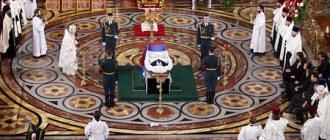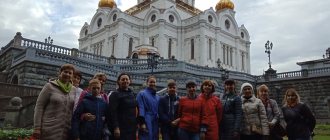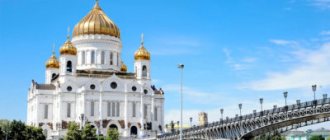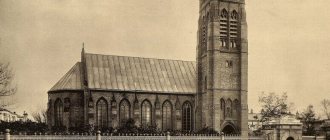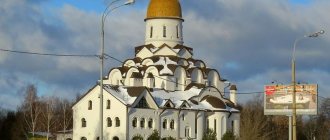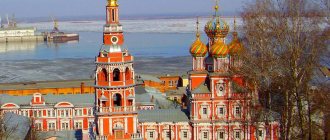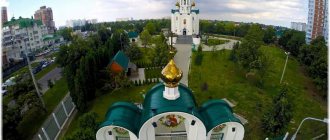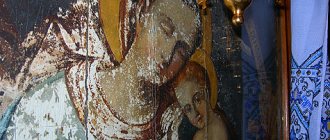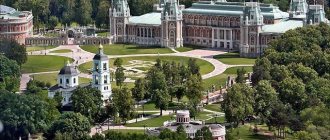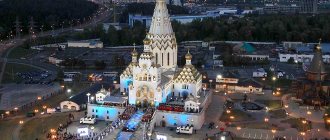The main church of Moscow and the whole country is the Cathedral of Christ the Savior. The Cathedral of Christ the Savior is the Cathedral of the Russian Orthodox Church located in the Russian capital, Moscow, within walking distance from Red Square and the Alexander Garden, on the Moscow River, at Volkhonka Street, 15-17.
The rector of the Cathedral of Christ the Savior is Patriarch Kirill of Moscow and All Rus'.
The Cathedral of Christ the Savior in Moscow was built as an object of gratitude to God for help and intercession during a difficult period in Russian history during the Napoleonic invasion during the Patriotic War of 1812. The temple also acts as a symbol and monument to the Russian people for their courage and heroism shown during hostilities.
The temple was erected according to the design of the architect K.A. Tona, May 26, 1883. Construction of the church lasted almost 44 years, the first stone was laid on September 23, 1839. Afterwards, at the height of Stalin’s reconstruction of the city on December 5, 1931, the temple building was destroyed. It was rebuilt only in 1994-1997. It is this Temple, newly erected in the 90s in the pseudo-Russian style, that we see now.
All major anniversaries and celebrations were and are held in the Cathedral of Christ the Savior. This Temple is one of the main attractions of the city, it is an integral part not only of the religious life of Moscow, it also serves as part of the culture and socio-political life of the entire country. Official website of the Cathedral of Christ the Savior in Moscow: xxc.ru.
You can get to the Cathedral and the Cathedral of Christ the Savior by metro. The nearest metro station is Kropotkinskaya. You can also get to the metro stations Teatralnaya, Okhotny Ryad, Alexander Garden or Arbatskaya, and then walk on foot to the Cathedral, at the same time see other main attractions of the country, such as Manezhnaya Square, Revolution Square, Mausoleum, the Moscow Kremlin and Alexander Garden.
The most beautiful view of the Cathedral of Christ the Savior opens from the Patriarchal Bridge. It is from this point that you can see the Temple in all its glory, without any inclinations or angles.
By the way, the Patriarchal Bridge in Moscow is also one of the ten main attractions of the city. This is a pedestrian bridge crossing the Moscow River and connects the Prechistenskaya and Bersenevskaya embankments, then the bridge runs across Bolotny Island, crosses the Vodootvodny Canal and ends at the Yakimanskaya embankment. The Patriarchal Bridge was built according to the design of the architect M. Posokhin, the artist Z. Tsereteli, and the engineers A. Kolchin and O. Chemerinsky, and opened in 2004.
The architecture of the bridge, like the Cathedral of Christ the Savior itself, is reminiscent of traditional Moscow architecture of the nineteenth century. At night, the bridge is illuminated by original shaped lamps built into the bridge deck.
The Patriarchal Bridge is a favorite walking place for guests and residents of the city. On it, lovers make dates, and those getting married take pictures and hang “locks of love.” There are a huge variety of these love locks on the bridge railings, here you can find small locks, large barn locks, and original personal ones made to order. Since the bridge is so visited, the city’s entrepreneurs did not ignore it. All over the bridge, here and there they offer to release pigeons, for a fee, of course. There are so many of these “pigeon tycoons” on the bridge and they are so intrusive that it is quite annoying.
From 2008 to 2011, New Year's addresses of Russian President Dmitry Medvedev were recorded on the bridge.
From the Patriarchal Bridge you can see the building of the Red October chocolate factory and the monument to Peter I. The monument to Peter the Great in Moscow is one of the tallest monuments in Russia, its total height reaches 98 meters. The official name of the monument is Monument in Commemoration of the 300th Anniversary of the Russian Navy. Erected in 1997 by order of the Moscow Government on an artificial island built at the separation of the Moscow River and the Vodootvodny Canal.
On the other side of the Patriarchal Bridge you can see the Kremlin embankment, the Kremlin wall and the buildings of the Kremlin complex - the State Kremlin Palace, the Annunciation and the Archangel Cathedrals.
View of the city from the Patriarchal Bridge
Let’s not stray far from the main topic of this article and return to the Cathedral of Christ the Savior.
The Cathedral of Christ the Savior in Moscow is the largest cathedral of the Russian Orthodox Church, its capacity is up to 10,000 people. The outer part of the cathedral is decorated with a number of marble high reliefs, and the main decoration is the golden domes with crosses crowning them.
The temple has 4 bells: the Great Solemn, its weight is 29.8 tons, its ringing can be heard only 4 times a year on the greatest Orthodox holidays, the Festive one, its voice can be heard on the days of the twelfth holidays, the Polyeleos weighing 9.2 tons and 5-ton Everyday.
This monumental structure, especially its golden domes, is clearly visible from many places in the city of Moscow. This happens due to the fact that the Cathedral is located on a hill.
From different angles one can see such different views of the Cathedral of Christ the Savior and its auxiliary buildings
The Cathedral of Christ the Savior has several entrances and exits, the main one from Volkhonka Street. It is from this street that you can get to the temple.
Entrance to the Cathedral of Christ the Savior is free and free. Pass through security and metal detectors. Filming and photography in the Temple is prohibited, so there are no photographs of the interior decoration. But we’ll tell you, we’ll tell you.
Inside, the Cathedral of Christ the Savior has high walls with vaulted ceilings, completely painted with colorful paintings and faces of saints. Rich colorful decoration, predominance of red and gold colors. The Temple has several floors and many halls. There are trade and souvenir shops. Museum of the Cathedral of Christ the Savior, admission is free, excursions are paid. The basis of the museum is made up of materials telling about the history of the construction, destruction and reconstruction of the Cathedral. The museum is a kind of monument in honor of the victory in the Patriotic War of 1812. And the gallery of military glory, here on marble plaques all the main events of the battles are listed in chronological order and fragments of surviving memorial slabs with the names of the heroes are presented.
Our personal opinion about the Cathedral of Christ the Savior. Big? Yes, big, massive and conspicuous! Beautiful? We don't think so. The feeling from the interior decoration is too much, it dazzles your eyes, as if you were in a tastelessly furnished museum. What was really beautiful about the Temple was the high vaulted painted ceilings. We admired them from the bottom of our hearts.
History of construction and birth of the idea
The idea of building a temple was voiced by General Peter Kikin in 1812. Its construction was supposed to mean gratitude to the Lord and Providence for the blessing sent to the victors.
Having listened to the wishes of the general, Russian Emperor Alexander I allowed the construction of the structure by signing a manifesto. After a competition for the right to present his own project, distinguished by its grandeur and monumentality, the winner was chosen - artist Karl Witberg.
To receive full approval of the project, Witberg converted to Orthodoxy. Before that, he was a member of the Masonic Order. For him, the construction of the temple carried a certain symbolism - the embodiment of the idea of the Freemasons in architecture.
The Emperor decided to choose Vorobyovy Gory as the location of the temple, where the foundation of the original building took place in 1817. The first few years of construction proceeded quite energetically - about 2 tens of thousands of peasants worked on them. Gradually the pace of work slowed down and by 1825 it stopped altogether. As a result, Vitberg was convicted of embezzlement and exiled to Vyatka, with all his property confiscated.
In 1831, the new Emperor Nicholas I appointed an architect, Konstantin Ton. In addition, the site of the construction of the temple was the land on Volkhonka. Construction started in 1837 and lasted almost 45 years.
The year 1880 brought the building its official name - the Cathedral of Christ the Savior. Three years later, the ceremony of consecration of the new building took place, accompanied by a march from the new Temple to the Assumption Cathedral and back.
The height of the Cathedral reached 104 m, allowing it to receive the title of the tallest building in Moscow. The capacity of this Temple exceeded all others in Russia. The construction of the Cathedral cost the country 14 million rubles.
The Cathedral of Christ the Savior very soon acquired special significance in the cultural life of Russia. All kinds of holidays, celebrations, weddings, and anniversaries were held there. The structure continued to operate during the revolution of 1917, and after it - until 1931. It was decided to build the Palace of the Soviets on the site of the Temple, and on December 5 the building was blown up. To destroy the remains, it was necessary to do this twice.
In 1988, the idea of rebuilding the temple appeared as repentance for sins before the Church. It was submitted by an initiative group, which later became a community. The referendum showed the desire and approval of many Soviet people to join the revival of the Temple.
In 1994, the Moscow City Hall adopted a resolution to begin construction. The designers of the future cathedral were M. Posokhin and A. Denisov. The final restoration of the Cathedral of Christ the Savior was completed in 1999, and in January 2000, from the 6th to the 7th, the first Christmas liturgy was held.
Architecture and style of the Temple
Dimensions:
- The building has a height of 103 meters;
- Wall width – 3 m;
- The length of the entire Temple is approximately 80 m;
- The volume of the structure is 524 thousand m³.
The cathedral includes several complexes:
- Upper Temple;
- Lower Temple;
- Stylobate part;
- Underground parking for 300 spaces.
The appearance of the Temple duplicates the established dogmas of the Russian-Byzantine style. The area covered with paintings in the Temple premises occupies approximately 22 thousand m². In addition, the lower corridor acts as a monument to military actions.
Most of the decoration of the Cathedral consists of ornaments made of 50 kg of gold. The internal vault of the dome is decorated with the composition “Fatherland” - an image of God and little Jesus. There are many paintings that personify the earthly life of Christ.
Shrines and relics of the Cathedral of Christ the Savior in Moscow
Reliquary with the relics of St. Philaret of Moscow (Drozdov), a piece of the Robe of our Lord and Savior Jesus Christ, the Ark with particles of holy relics, the Robe of the Most Holy Theotokos, the Head of St. John Chrysostom, the Relics of the Blessed Grand Duke Alexander Nevsky, the Relics of St. Jonah Metropolitan of Moscow, the Relics of the Great Equal to the Apostles Prince Vladimir, Relics of the Venerable Mary of Egypt and the Blessed Prince Michael of Tver, Relics of St. Peter Metropolitan of Moscow, Relics of St. Basil the Great, Relics of John the Baptist, Relics of the Apostle Andrew the First-Called, Nail of the Holy Cross, Relics of St. Michael Malein, Relics of the Holy Great Martyr Theodore Stratelates, Relics of the Great Martyr Euphemia of All Praise, Head of St. Gregory the Theologian, Relics of the Venerable Euphrosyne of Moscow.
Interesting facts about the Temple
It is not surprising that a building with such a rich history and difficult path of formation has its own mysteries and facts that awaken the interest of numerous tourists.
Here are some of them.
- Once upon a time, during pagan times, on the territory of the modern Temple there was a temple of Veles. In addition, the first mosque in Moscow was built here. The pagan priests, according to legend, endowed this place with a curse when leaving it.
- One of the maids of the monastery, which was demolished for the construction of the Cathedral, resisted leaving her territory. She tied herself to a tree and proclaimed a curse before burning with the remains of her monastery. They say that the “eternal” renovation of the Cathedral is the result of the woman’s last will.
- For the most part, the construction of the Cathedral was carried out with funding from the Russian people. Voluntary contributions were organized, which were supported by money from patrons.
- The wreckage of the Temple, which remained after the explosion in 1931, was used in the construction of the metro. Marble slabs have been preserved at some metro stations. Kroshevo with the names of Russian heroes can be found on the paths of city parks.
- The Cathedral of Christ the Savior several times became the center of rallies and scandalous actions. Feminists protested against the elections to the State Duma, and a year later they staged a defiant concert at the very altar.
- There is a car wash in the Cathedral of Christ the Savior.
- It is believed that the Moscow swimming pool, which closed in 1994, is the result of the 1931 Cathedral explosion. In fact, the location of the Temple was a little out of the way.
The Cathedral of Christ the Savior is rightfully considered the main shrine of the country and one of the most popular attractions in Moscow, attracting thousands of believers and tourists from all over the world.
Scheme of the Church of the Resurrection of Christ
The Church of the Resurrection of Christ in Jerusalem is the spiritual center of the earth, where the Savior of the human race suffered, died on the Cross, was buried and rose from the dead. Nowadays it is a majestic architectural complex, including Golgotha with the place of the crucifixion, the Rotunda (the dome covering the Edicule), the Catholicon (the cathedral church for the Patriarchs of the Orthodox Church of Jerusalem), the underground Church of the Discovery of the Life-Giving Cross, the Church of St. Helen Equal to the Apostles and a number of chapels.
Scheme of the Church of the Resurrection of Christ
1–2. Small Church (Kuvuklia) Kuvuklia (a cave measuring 8.3 x 5.9 m) consists of two parts: the western, hexagonal in plan (2.07 x 1.93 m), where the Holy Sepulcher is located, and the eastern (3.4 x 3.9 m), where the Angel's chapel is located.
The pedestal with part of the sacred Stone rolled away by the Angel is located in the middle of the chapel and serves as a throne during the celebration of the hierarchal Orthodox liturgy at the Holy Sepulcher (the altar in this case becomes the Triday Bed itself). In the northern and southern walls there are oval windows for the transmission of the Holy Fire on Holy Saturday (northern - for Orthodox, southern - for Armenians). In the 16th century, when the Armenians, with the help of the Turks, decided to receive the Holy Fire on their own and did not allow the Orthodox into the Church of the Resurrection, the Fire came from a column at the entrance to the temple where the Orthodox Patriarch stood. And now, before entering the temple, our compatriots kiss this cut and burnt column - a witness to the truth of the Orthodox faith. The Cave of the Holy Sepulcher is almost half occupied by a stone bed covered with a marble slab, which appeared in Edicule in 1555. Maximus Simeos, who was the last to see the Savior’s stone bed without a covering slab in 1810, testified that it was severely damaged by the unreasonable jealousy of countless “God-lovers” ”, who strove to break off, bite off, and take away a piece of the shrine with them at any cost.
The patron inscription above the door names the creator of the Edicule - the Greek architect N. Komninos, who was martyred by the Turks in Constantinople on Easter 1821. In the western part of the Edicule is attached the Chapel of the Head, belonging to the Coptic Church. According to legend, the second Angel sat here.
3. The graves of Joseph of Arimathea and Nicodemus - disciples of Christ
4. Adam's chapel is located under Golgotha. Behind the throne, through the iron bars, you can see the Golgotha Cleft. According to legend, the head of Adam was buried here. In this chapel is located the Sanctuary of the Church of the Holy Sepulcher - a repository of shrines, where at certain times you can fall before a particle of the Life-Giving Tree, the relics of Christian saints.
5. Golgotha The place of the crucifixion and the discovery of the Cross of the Lord. The Most Pure Blood of the Savior spilled through a crevice in the rock, washing away the sin of Adam. The crack was formed during the earthquake that accompanied the crucifixion of Christ. The open Calvary throne is marked by a round hole into which the Life-giving Cross of the Lord was placed. The crosses of the robbers, standing somewhat behind the Cross of the Savior, are indicated by black circles on the marble platform of Calvary. The Greek throne of Golgotha is separated by a colonnade from the Roman Catholic side chapel, located to the right of the Orthodox one.
Between the Catholic and Orthodox altars is the Franciscan altar of Our Lady of Sorrows. At the site of the Catholic throne, according to legend, soldiers nailed the Savior to the Cross.
Calvary
6. Golgotha Rock
7. Remains of the foundation of the temple built by Emperor Constantine IV Monomakh (1042) - the grandfather of Vladimir Monomakh 8. Catholicon The main chapel of the Temple of the Resurrection, belonging to the Orthodox Church of Jerusalem. At the entrance to the chapel from the side of the Holy Sepulcher there is a marble vase with a cross on a globe, symbolizing the spiritual center of the earth - according to the words of the psalmist David: “Thou hast wrought salvation in the midst of the earth, O God.”
9. Remains of the basilica of Emperor Constantine (335)
10 (1). Passages
10 (2). Gallery
11. Stone of Anointing Located opposite the entrance to the Church of the Holy Sepulchre. Covered with a red marble polished slab 30 cm thick. The Greek text of the troparion of St. is carved on its sides. Joseph of Arimathea. The Gospel verses (John 19:38–40) are written in Greek on a marble plaque hanging on the right. The removal of the Lord from the Cross, the anointing of the body with incense and the position in the Tomb are depicted on a large mosaic panel located directly behind the Stone of Anointing. The mosaic was completed with the blessing of Patriarch Diodorus in 1990 by V. Tsotsonis. Above the Stone there are eight lamps (four Orthodox, two Armenian, Latin and Coptic).
There is no evidence available to us about exactly where the Body of the Lord was prepared for burial. But already from the 5th century. In the observance of Good Friday, the rite of the Burial of the Shroud is highlighted. In the temple it is performed as follows: the Shroud covered with rose petals is transferred by six bishops from Golgotha to the Stone of Anointing; after the litany at the Stone, the Shroud is solemnly transferred with a threefold litany around the Edicule and placed on the Three-Day Bed, then taken to the altar of the Catholicon.
Stone of Anointing
11. Place of mourning for Christ (“Don’t cry for Me, Mother”)
12. Southern part of the Basilica of Constantine the Great
13. The chapel of the Orthodox Syrians (Syro-Jacobite Church) The chapel is owned by the Armenians, who allow the Syrian clergy to perform services here on Sundays and holidays. A small passage leads from it to the graves of the righteous Joseph of Arimathea and Nicodemus.
14. Northern part of the Basilica of Constantine
15. Chapel of Mary Magdalene Here the Lord appeared to her after His Resurrection, saying: “Do not touch Me” (John 20:17). Nowadays it is a Catholic chapel of the temple with a modern stylized sculptural depiction of the event.
16. Arcades of the Virgin Huge tetrahedral pillars located in the northern gallery of the temple and supporting high arches.
17. Franciscan Sacristy The sword and spurs of the Crusader king Godfrey of Bouillon (1060–1100) are kept here.
18. Catholic chapel of the Virgin Mary (Church of the Appearance of the Risen Lord to the Blessed Virgin Mary) Here is the Pillar of Flagellation - part of the column to which, according to legend, the Lord Jesus Christ was tied. In the same church, the place where a dead woman was resurrected from touching the Life-Giving Cross of the Lord on the day of its discovery is revered.
19. Franciscan monastery, attached to the northern part of the temple complex
20. Orthodox chapel of the Prison of the Lord, or Chapel of the Uz. Before the entrance to the chapel, under the altar, there is a stone slab with two holes for the feet. Made by analogy with the shackled stone bench in Pretoria - the Supreme Court, where Christ was condemned to death. Orthodox believe that the Mother of God stood here with the holy women and looked at the nailing of Her Son to the Cross. Previously, in one of the niches of the Prison of Christ, an icon of the Most Holy Theotokos was placed, “crying” during Holy Week. Today the image has been restored by the nuns of the monastery of St. Mary Magdalene in Gethsemane and transferred to their temple. 21. Chapel of Longinus the Centurion The holy martyr Longinus the Centurion (centurion) believed during the death of the God-man at the sight of wondrous signs. “The centurion and those who were with him guarding Jesus, seeing the earthquake and everything that happened, were greatly afraid and said: Truly this was the Son of God” (Matthew 27:54). Tradition says that this Greek chapel was built on the site where a blind woman found the head of St. Longinus, who suffered for Christ. This woman received her sight. Part of the stone from Golgotha is also located here. 22. The chapel of dividing the Lord's garments At this place, “those who crucified Him divided His garments, casting lots for who would receive what” (Mark 15:24). The chapel belongs to the Armenian Patriarchate. But the Armenians also consider it the chapel of Longinus the Centurion, since his spear was once kept under the throne. 23. The chapel of ridicule or the laying of the Crown of Thorns is located to the right of the chapel of Adam. Here, under the altar, a piece of stone brought from Pretoria is kept. The Lord sat on the stone while the purple robe and the Crown of Thorns were placed on Him. The chapel belongs to the Greek Church.
24. Church of St. Helena From the aisle of the Crown of Thorns, 28 steps lead down to the underground church of St. Helena, which belongs to the Armenians. The northern altar is dedicated to the Prudent Thief; the central one - to Queen Helena and Gregory the Illuminator. 24. Chapel of St. Vardan In 1970, with the blessing of the Armenian Patriarch, the space to the northeast of the apse of the church of St. was explored. Elena. We discovered a room to which access had been closed since ancient times. This newly found part of the temple was named the Chapel of St. Vardan the General, or Armenian Warrior Martyrs, with a passage from the church of St. Elena. In the center of the chapel there is an altar in the name of 1036 Armenian martyrs who died during the Armenian-Persian War in 451.
25. Chapel of the Finding of the Life-Giving Cross Twelve steps down lead from the Church of St. Helena to the dungeon where the queen found the Life-Giving Cross. Nowadays this is the Greek throne. Huge fragments of natural rocks are visible in the dungeon - in the form in which they remained after the earthquake during the crucifixion of Christ. The dungeon is located on the site of a former hollow called the Valley of the Dead, where bodies and crosses were thrown after the crucifixion.
Place of Finding the Life-Giving Cross of the Lord
26. Temple Gate 27. Tomb of the knight Philip d'Aubigny The knight was a participant in the crusade of the German Emperor Frederick II, who managed to briefly take possession of the Holy City.
28. Chapel of the Franks To the right of the entrance to the temple you can see a small staircase, 12 steps of which lead up to the medieval chapel. This staircase once served as a separate entrance to Golgotha. Then the passage was closed, and the building, a kind of “atrium” of Golgotha, was turned into a chapel. Nowadays it is called the Chapel of the Franks and belongs to the Catholic order of Franciscan monks.
Under the Chapel of the Franks there is a small chapel dedicated to Mary of Egypt. There is a legend that the conversion of a former harlot took place here, and after her painful repentance she became one of the most revered saints of the Church of Christ. Stepping onto the stairs leading to Golgotha, she suddenly felt that she could not climb the steps under the unbearable weight of her sins. But by calling on the intercessor of sinners, the Most Holy Theotokos, the harlot Mary gained the strength to ascend the Holy Mountain.
29. Reservoir under the atrium of the temple
30. Chapel of Archangel Michael. Located to the right of the Frank Chapel, it belongs to the Coptic Church.
31. Armenian chapel of St. John the Evangelist
32. Greek Monastery of St. Abraham
33. Church of St. James, Brother of the Lord, is the parish church of the Orthodox of Jerusalem
34. Greek Orthodox Chapel of St. Mary Magdalene.
35. Bell tower and Church of the Forty Martyrs of Sebastia The bell tower was built by the French architect Jourdain in 1160–1180, under it is the church-tomb of the Patriarchs of Jerusalem.
36. Staircase to the Greek monastery
37. Temple courtyard (Atrium) Laid out on stones remaining from the pagan sanctuary of the era of Emperor Hadrian. Below it remains a large Roman cistern (29).
